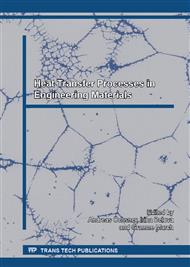p.121
p.129
p.135
p.147
p.159
p.169
p.185
p.195
p.209
AC Magnetic Heating of Superparamagnetic Fe and Co Nanoparticles
Abstract:
AC magnetic heating of superparamagnetic Co and Fe nanoparticles for application in hyperthermia was measured to find a size of nanoparticles that would result in an optimal heating for given amplitude and frequency of ac externally applied magnetic field. To measure it, a custom-made power supply connected to a 20-turn insulated copper coil in the shape of a spiral solenoid cooled with water was used. A fiber-optic temperature sensor has been used to measure the temperature with an accuracy of 0.0001 K. The magnetic field with magnitude of 20.6 μT and a frequency of oscillation equal to 348 kHz was generated inside the coil to heat magnetic nanoparticles. The maximum specific power loss or the highest heating rate for Co magnetic nanoparticles was achieved for nanoparticles of 8.2 nm in diameter. The maximum heating rate for coated Fe was found for nanoparticles with diameter of 18.61 nm.
Info:
Periodical:
Pages:
159-167
Citation:
Online since:
March 2013
Keywords:
Price:
Сopyright:
© 2013 Trans Tech Publications Ltd. All Rights Reserved
Share:
Citation:


